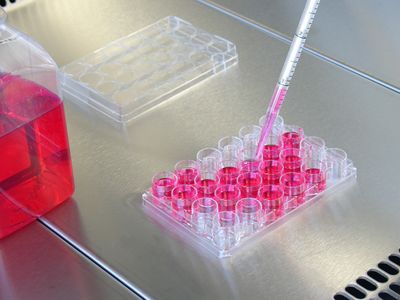ABOVE: © ISTOCK.COM, CHRISTOPH BURGSTEDT
Using light to control the interactions between a transcription factor and a gene promoter, a team of engineers has shown that specific interaction patterns can result in distinct levels of gene activity. In their paper, published this week (August 31) in Cell Systems, the team suggests this novel gene control mechanism could be harnessed for biotechnological applications.
“It’s pretty cool; it’s pretty novel. It takes a different view of how gene regulation works, or can work,” says bioengineer Jeff Tabor of Rice University who was not involved in the study. The study shows “how information can be encoded [in dynamic signals] . . . and how we can modify it to be able to program cellular behavior,” he says.
“It was a very impressive paper,” agrees bioengineer Lukasz Bugaj of the University of Pennsylvania who also did not participate in the project. “It’s a very systematic, quantitative look at how such information is transmitted across a promoter.”
The textbook description of gene regulation, Bugaj explains, holds that an activating protein, known as a transcription factor, binds to a gene’s promoter region to start transcription. But “of course we know it’s more complicated than that.” It’s not simply the presence or absence of a transcription factor that switches a gene on or off, he says. A number of elements can influence the amount of expression.
There may be differences in the total amount of available transcription factor, for instance, or in the accessibility of the promoter because of local changes to chromatin structure—that is, the way the DNA is wrapped around its associated proteins. Variations in the dynamics of a given transcription factor also seem to influence gene expression outcomes, says Tabor. For example, certain transcription factors have been found to either shuttle between the nucleus and cytoplasm, or to stay in the nucleus long-term. You can think of it like a visiting relative, he says. “Your mom could come visit you for a week straight, or she could come one day a month for seven months.” The total time she spends in your house would be the same, but the effect would be very different.
But while evidence suggests different dynamics of transcription factors induce different outcomes, it’s been a challenge to study the phenomenon systematically. This is in part because studies have tended to look at natural gene–transcription factor interactions where other confounding influences—such as modifications to transcription factors or associations with other proteins—could be at play.
“The direct question that needs to be answered is, do genes actually respond differently to these different dynamic patterns? Is it really the dynamics that are important?” says Albert Keung, who studies synthetic biology at North Carolina State University and led the research.
To answer this question, Keung took a synthetic, “super-reductionist” approach, he says, to rule out confounding variables. “What we wanted to do was very directly control the transcription factor binding, or not binding, to the gene promoter.”
The team made a synthetic gene, encoding a fluorescent reporter protein and controlled by a light-inducible promoter, and stably transfected it into the yeast Saccharomyces cerevisiae. The yeast were engineered to produce a specially-designed transcription factor such that when the cells were exposed to blue light, the transcription factor would bind to the promoter and activate transcription. When the light was switched off, the factor was released.
Yeast cells containing the synthetic gene were grown in multiwell plates, with each well exposed to its own programmable LED light. The wells received different light patterns that varied in pulse frequency, duration, and intensity, for 14 hours, at which point the researchers chemically halted gene expression and analyzed the cells using flow cytometry. A total of 119 light patterns were tested.
The data revealed that, in general, more light (that is, more photons hitting the cells) induced more gene expression. However, this was not always the case. In some instances, different patterns of light (and therefore different transcription factor dynamics) induced levels of expression that varied significantly—“over an order of magnitude different,” says Keung—despite delivering the same total number of photons.
In another set of experiments, the team tested how different chromatin regulating proteins affected outputs and found that some chromatin regulators resisted certain interaction patterns altogether, such that the gene barely expressed the fluorescent protein at all. In contrast, other chromatin regulators induced high levels of gene expression in response to certain dynamic patterns even though the total light level was low.
Of the three light pulse parameters tested—frequency, intensity, and duration—the team found that “frequency seemed to transmit the most information” through the promoter, says Keung. Put another way, altering the frequency of the light pulses gave the team more precise control over gene activity than did altering pulse duration or light intensity.
Together, the results suggest that eukaryotic gene promoters do indeed have the capacity to interpret signal dynamics and alter their output accordingly. Such information not only widens our understanding of gene regulatory mechanisms, but might also be valuable in biotechnology endeavors, says chemical engineer Katie Galloway of MIT who was not part of the research team.
She writes in an email to The Scientist, “By improving our understanding of how gene regulation works, [the authors] provide exciting opportunities for improving the performance of engineered circuits and cells.”





